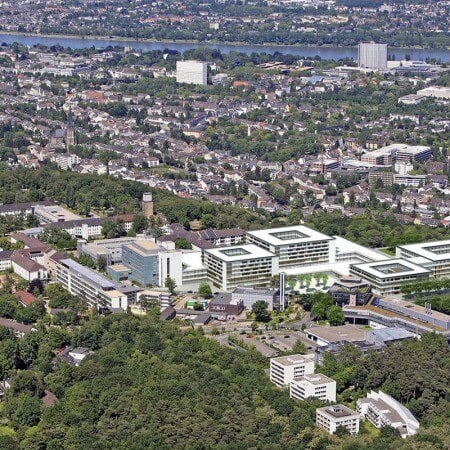Chronic lymphoblastic leukemia is the most common type of leukemia in adults and occasionally occurs in children. Chronic leukemia is not as aggressive as acute leukemia, but it is more difficult to cure completely. The treatment of pathology mainly involves drug therapies; less often, doctors resort to splenectomy, radiation therapy and stem cell transplantation.
Content
- Main treatment methods
- Complementary treatment methods
In most cases, drug therapy is indicated. Doctors use medications that are administered intravenously or taken orally in the form of pills and capsules. Sometimes irradiation, spleen removal surgery, leukapheresis, and allogeneic stem cell transplantation are required.
You can go to the University Hospital Freiburg, the University Hospital Heidelberg, or the University Hospital Frankfurt am Main.
You do not have to organize your trip on your own. The specialists of Booking Health company will take care of your treatment arrangement in Germany.
Main treatment methods
Chemotherapy is the main treatment for chronic lymphoblastic leukemia in adults and children. Physicians use purine analogs, glucocorticoids, and alkylating agents. The treatment is carried out in cycles of 3-4 weeks.
Monoclonal antibodies usually complement chemotherapy. Doctors use antibodies that target these molecular targets:
- CD20 is the primary, most commonly used drug. Some drugs are given immediately, and others are used as second-line therapy.
- CD52 is used when patients no longer respond to other treatments.
- CD22 – drugs targeting this antigen are used to treat patients with hairy cell leukemia. Physicians use an antibody-drug conjugate. Antibodies deliver chemotherapy agents directly to cancer cells.
Targeted therapy involves using drugs that target particular molecular targets in cancer cells. Some targeted therapy drugs are combined with chemotherapy to treat patients initially. The following groups of drugs are used in Germany:
- Bruton's tyrosine kinase inhibitors (they are often used as first-line drugs and also successfully cope with recurrences of chronic leukemia and are used for chromosome 17 deletion);
- PI3K inhibitors are used in cases where other therapy options do not work;
- specific inhibitors of Bcl-2 protein (BH3 mimetics).
Stem cell transplantation is used for severe types of leukemia: with deletions of chromosome 17 and TP53 mutations, no response to chemotherapy. Doctors conduct high-dose chemotherapy to destroy all cancer cells in the body and then perform stem cell transplantation to restore the bone marrow. In the case of leukemia, allogeneic cell transplantation from a donor is more often performed.
Complementary treatment methods
Splenectomy is a rarely performed operation for chronic lymphocytic leukemia, which can relieve the symptoms of the disease. With this pathology, the spleen can greatly increase in size, and in this case, it begins to compress the adjacent organs. Doctors first try to shrink the spleen with drugs and irradiation, and if this fails or if acute complications develop, surgery becomes an option of choice. After splenectomy, the number of cells in the blood increases, and the need for blood transfusions decreases. Splenectomy is most effective in patients with hairy cell leukemia. However, the treatment method also has disadvantages: a weakened immune system and an increased risk of infection.
Radiation therapy is used infrequently. It is used when necessary to quickly suppress symptoms, for example, caused by an enlarged spleen. When the neoplasm spreads to the bones, radiation helps to relieve pain and prevent bone fractures. In addition, total body irradiation is carried out along with high-dose chemotherapy before stem cell transplantation.
Leukapheresis is performed in case of blood thickening due to the accumulation of many pathological white blood cells. This procedure is required to prevent respiratory and heart failure. During the procedure, blood is passed through a special apparatus that selects excess cells. Manipulation takes several hours. It is usually performed before the start of chemotherapy.
Maintenance therapy eliminates not the disease itself but its consequences. Doctors use intravenous immunoglobulin, antibiotics, vaccines, and antivirals to prevent and treat infections. With a low level of platelets and red blood cells, blood and its components are transfused. Doctors also use medications that increase the production of red blood cells. In the case of the development of hemolytic anemia during the treatment of chronic lymphoblastic leukemia, glucocorticoid therapy is performed to suppress autoimmune reactions.
To undergo treatment for chronic lymphoblastic leukemia in Germany, please use the Booking Health service. Our website presents information on how much the price of treatment is. You are welcome to compare the cost of treatment and diagnostics in different clinics in Germany to book a medical care program at affordable prices. The Booking Health specialists will help you choose a medical center and arrange your trip.
Authors:
The article was edited by medical experts, board certified doctors Dr. Vadim Zhiliuk and Dr. Sergey Pashchenko. For the treatment of the conditions referred to in the article, you must consult a doctor; the information in the article is not intended for self-medication!
Sources:
National Cancer Institute
Cancer Research Institute
Sience Direct




















